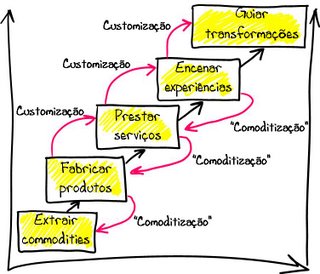Um daqueles postais que custam clientes...
Não consigo segurar-me, o cinismo toma conta de mim e não consigo pará-lo.
Inovação, Indústria 4.0, fábrica do futuro, plataformas colaborativas, workflow, soluções inteligentes, ...
Cut the chase, vamos ao essencial:
Quando me vierem falar de inovação e Indústria 4.0, por favor, foquem-se numa coisa apenas: a margem cresce, sim ou não? E se cresce, como ou porque cresce? E claro, quanto cresce?
A margem cresce quando:
- o cliente está disposto a pagar mais pelo produto, aumento do preço de venda (Marn e Rosiello mostraram o quão poderoso é este aumento)
- o custo final baixa, a inovação permite reduzir os custos de fabrico, sem pôr em causa a qualidade, sem prejudicar o desempenho do produto final (Marn e Rosiello mostraram a limitação deste tipo de poupança, embora seja benvinda)
O que li:
"Sempre na linha da frente da produção de calçado, a XXXX com a força do digital e da tecnologia desenvolveu um projecto onde casou a manufactura tradicional com o conhecimento tornando-se exemplo de aplicação do conceito de indústria 4.0.
...
YYYY revelou que sentia “uma certa vaidade” por mostrar soluções que eram o resultado prático dos problemas do dia-a-dia que uma empresa industrial e de manufactura encontram.
Uma dessa soluções foi encontrada, em plena pandemia, em que o processo de consultar e mudar fichas, em papel, de instruções de fabrico, foi substituída por um tablet, eliminando um potencial foco de contaminação e infecção pela utilização do dedo e da saliva, dos trabalhadores envolvidos.
...
Todas estas novidades, foram reformas assumidas no sector o que aumentou a produtividade das empresas
...
No que toca ao digital, o ZZZ permitiu uma maior utilização de tecnologias que serviram o processo de fabrico, ajudaram à desburocratização de processos, e ajudaram ao desenvolvimento de plataformas de e-commerce.
Também, uma aplicação – IIOT – que permite ligar sensores a máquinas e a sistemas de informação e o armazenamento de dados na nuvem, fez com que se construísse um sistema ciber-físico com vantagens em todo o processo de fabrico do calçado."
Já chega...
Há aqui alguma coisa que ajude a aumentar preços?
"o que aumentou a produtividade das empresas" em quanto, fizeram contas? Apresentaram números? Por que é que o jornal não os publicou?
Como não recordar a minha última conversa oxigenadora...
Seria interessante daqui a seis meses uma visita para confirmar que este tipo de "inovações" continuam a ser utilizadas.
"uma aplicação – IIOT – que permite ligar sensores a máquinas e a sistemas de informação e o armazenamento de dados na nuvem" e depois, quem analisa e trabalha esses dados?
Ainda esta semana comentava numa empresa de calçado que há 30 anos, quando comecei a trabalhar como consultor, as empresas contratavam alguém para a função da qualidade quando decidiam avançar para a implementação de um sistema da qualidade. Agora, quase nenhuma o faz. Resposta: temos de ter estruturas leves porque sofremos muito na primeira década deste século e não queremos voltar a cometer o mesmo erro. Sorri, lembrei-me do engenheiro H. perdido numa linha de montagem, porque quem não trabalhava na linha era malandro.
Para terminar com um tom mais optimista. Quando me vierem falar em inovação no calçado, falem-me em "é meter código nisso".











%2006.21.jpeg)












